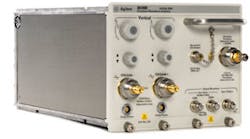Low jitter is critical when making evaluations on waveforms in new communications systems. Over the next several years, numerous high-data-rate communications standards will emerge with rates exceeding 25 Gb/s per channel, creating a need for a fast and stable test solution. The model 86108B precision waveform analyzer from Agilent Technologies is a plug-in module for the company's 86100C/D DCA line of high-speed sampling oscilloscopes. The 86108B waveform analyzer module ( Fig. 1) features an integrated precision timebase and clock-recovery circuitry that achieve residual jitter levels better than 50 fs root mean square (RMS), with analog channel bandwidths to 50 GHz and clock-recovery rates to 32 Gb/s.
This "MegaModule" waveform analyzer plugs into a 86100C/D DCA oscilloscope, turning it into a high-performance and flexible measurement system (Fig. 2). With its integrated clock-recovery circuitry, the module can trigger directly from single-ended or differential data signals. The module features internal phase-matched cables to preserve the signal integrity (SI) of signals under analysis.
This compact module is actually a small measurement subsystem with numerous function blocks, including the integrated triggering circuitry, wide-bandwidth receivers, and the high-performance clock-recovery circuitry. The wide clock-recovery range greatly simplifies compliance testing on equipment related to a number of emerging communications standard. Clock recovery is often required as part of high-speed-standard compliance testing.
The flexibility of the 86108B precision waveform analyzer module is further enhanced by its various options. These include its availability as a low-bandwidth (LBW) model with two channels having analog bandwidth of 35 GHz and as a high-bandwidth (HBW) model with analog bandwidth of 50 GHz across two input channels. For the LBW module, the residual jitter is specified as less than 90 fs (with typical performance of better than 60 fs). The noise for this unit is specified as 700 V, with typical performance of 500 V. This 35-GHz waveform analyzer module has two options for internal clock-recovery capabilities: 50 Mb/s to 16 Gb/s (Option 216) and 50 Mb/s to 32 Gb/s (Option 232).
For the HBW model, the residual jitter is specified as less than 70 fs (with typical performance of better than 50 fs). The noise for this unit is specified as 980 V, with typical performance of 800 V. As with the LBW module, the HBW module offers the same two options for internal clock-recovery capabilities: 50 Mb/s to 16 Gb/s (option 216) and 50 Mb/s to 32 Gb/s (option 232). Both the bandwidth and clock-recovery options can be upgraded by returning the module to Agilent.
The 86108B precision waveform analyzer module is an addition to the 86100C/D DCA family of oscilloscopes. It provides a full-rate recovered clock output for data signals to 16 Gb/s and a divided clock for data signals above 16 Gb/s. It enables simple connections to a device under test (DUT), with no extra cables required.
The module also provides probe power to Agilent's InfiniMax probes using N1022B/N5477A adapters. The module accepts precision timebase input signals to 16 GHz with 0-ns clock-data delay on a 3.5-mm connector. It uses SMA connectors on the auxiliary clock-recovery input port. P&A: $80,000 and up.
Agilent Technologies, Inc., 5301 Stevens Creek Blvd., Santa Clara, CA 95051; (877) 424-4536, FAX: (408) 345-8475, e-mail: [email protected], www.agilent.com.
